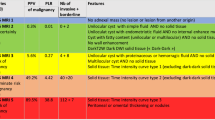Abstract
Background
There are no studies on utility of MRI in management of pediatric adnexal masses.
Objective
To determine the diagnostic and therapeutic impact of pelvic MRI in adnexal masses in children and adolescents.
Materials and methods
We included 32 females age 18 years and younger who had adnexal masses and who underwent both pelvic ultrasound (US) and MRI. A radiologist retrospectively reviewed US and MR images and created a standard radiologic report for each patient. In a prospective theoretical fashion, two pediatric gynecologists reviewed the clinical data and US report for each patient and indicated conservative versus surgical management; in surgical cases the options were laparoscopy versus laparotomy, midline versus Pfannenstiel incision, and oophorectomy versus cystectomy. Subsequently, the gynecologists were presented the MRI report and were asked to indicate their treatment options again. A binomial test was conducted to determine the effect of adding MRI findings to the management plan.
Results
The addition of MRI significantly changed management in 10 of 32 patients (P=0.0322), with a change in surgical versus conservative treatment in 5, a change in laparotomy vs. laparoscopy in 2, and a change from oophorectomy to cystectomy along with change in incision in 3 cases. This was based on additional information provided by MRI regarding the nature of the mass in 8 cases and origin of the mass in 2 cases.
Conclusion
Preoperative pelvic MRI findings might change the surgical management of pediatric patients with adnexal masses, so it is a valuable addition to the conventional workup in the clinical management.




Similar content being viewed by others
References
Cartault A, Caula-Legriel S, Baunin C et al (2012) Ovarian masses in adolescent girls. Endocr Dev 22:194–207
Kirkham YA, Lacy JA, Kives S et al (2011) Characteristics and management of adnexal masses in a Canadian pediatric and adolescent populations. J Obstet Gynaecol Can 33:935–943
Skiadas VT, Koutoulidis V, Eleytheriades M et al (2004) Ovarian masses in young adolescents: imaging findings with surgical confirmation. Eur J Gynaecol Oncol 25:201–206
Mitchell DG, Javitt MC, Glan P et al (2013) ACR appropriateness criteria and follow-up of ovarian cancer. J Am Coll Radiol 10:822–827
Sala E, Rockall AG, Freeman SJ et al (2013) The added role of MR imaging in treatment stratification of patients with gynecologic malignancies: what the radiologist needs to know. Radiology 266:717–740
Ratner ES, Staib LH, Cross SN et al (2015) The clinical impact of gynecologic MRI. AJR Am J Roentgenol 204:674–680
Chilla B, Hauser N, Singer G et al (2011) Indeterminate adnexal masses at ultrasound: effect of MRI imaging findings on diagnostic thinking and therapeutic decisions. Eur Radiol 21:1301–1310
Hricak H, Chen M, Coakley FV et al (2000) Complex adnexal masses: detection and characterization with MR imaging — multivariate analysis 1. Radiology 214:39–46
Ruwe PA, Wright J, Randall RL et al (1992) Can MR imaging effectively replace diagnostic arthroscopy? Radiology 183:335–339
Schwartz LB, Panageas E, Lange R et al (1994) Female pelvis: impact of MR imaging on treatment decisions and net cost analysis. Radiology 192:55–60
Hricak H, Powell CB, Yu KK et al (1996) Invasive cervical carcinoma: role of MR imaging in pretreatment work-up — cost minimization and diagnostic efficacy analysis. Radiology 198:403–409
Van Winter JT, Simmons PS, Podratz KC (1994) Surgically treated adnexal masses in infancy, childhood, and adolescence. Am J Obstet Gynecol 170:1780–1786
Oltmann SC, Garcia N, Barber R et al (2010) Can we preoperatively risk stratify ovarian masses for malignancy? J Pediatr Surg 45:130–134
Adusumilli S, Hussain HK, Caolli EM et al (2006) MRI of sonographically indeterminate adnexal masses. AJR Am J Roentgenol 187:732–740
Sohaib SA, Mills TD, Sahdev A et al (2005) The role of magnetic resonance imaging and ultrasound in patients with adnexal masses. Clin Radiol 60:340–348
Luijendijk RW, Jeekel J, Storm RK et al (1997) The low transverse Pfannenstiel incision and the prevalence of incisional hernia and nerve entrapment. Ann Surg 225:365–369
Biswas KK (1973) Why not Pfannenstiel’s incision? Obstet Gynecol 41:303–307
El-Boghdadly SA, Abel K (1984) Pfannenstiel incision for appendicectomy in females. Br J Clin Pract 38:17–19
Acknowledgments
Alessandro Marro received equal funding from Comprehensive Research Experience for Medical Students (CREMS), Faculty of Medicine, University of Toronto and Department of Medical Imaging, University of Toronto as a medical student for this research.
Author information
Authors and Affiliations
Corresponding author
Ethics declarations
Conflicts of interest
None
Rights and permissions
About this article
Cite this article
Marro, A., Allen, L.M., Kives, S.L. et al. Simulated impact of pelvic MRI in treatment planning for pediatric adnexal masses. Pediatr Radiol 46, 1249–1257 (2016). https://doi.org/10.1007/s00247-016-3606-y
Received:
Revised:
Accepted:
Published:
Issue Date:
DOI: https://doi.org/10.1007/s00247-016-3606-y




